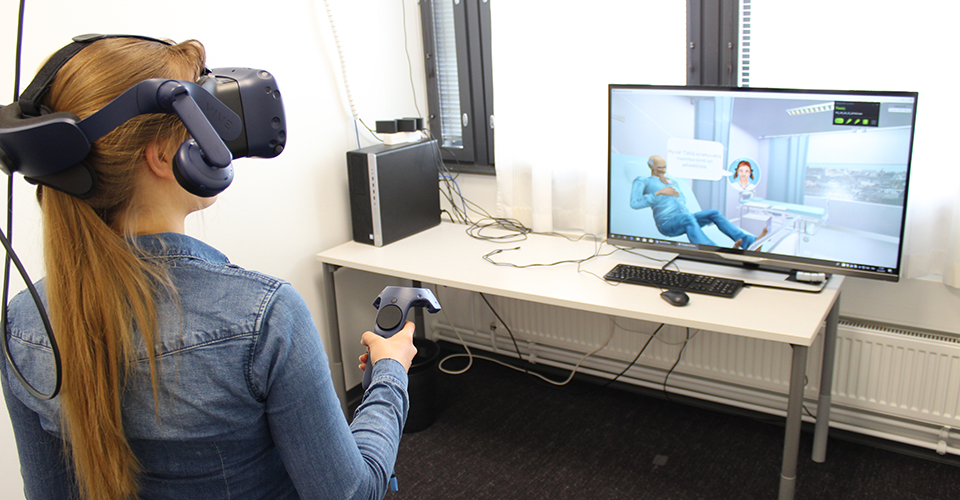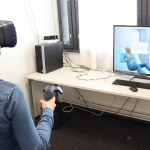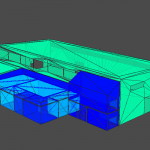
Jaana-Maija Koivisto
Safe patient care requires continual practice and skills maintenance. Learning methods which model real life situations, such as simulation games and virtual reality, enable the safe practice of decision-making on patient care.
The HAMK Smart Research Unit is studying, together with the School of Wellbeing, the possibilities for using simulation games and virtual reality to promote patient safety. Through the cooperation, knowledge will be produced on integrating simulation games and virtual reality into teaching. In addition, the research will generate new knowledge on the impact of simulation games on clinical reasoning skills for nursing care of surgery patients as well as user experiences of VR simulation games. The results of the study can be utilised when considering the impact of different kinds of teaching methods on students’ learning experiences.
Defects in patient safety
International reports have estimated that one in ten patients is harmed while receiving care, and one in a hundred suffers serious harm (WHO, 2017). It has been estimated that these figures are applicable also to Finland, and on this basis, it is estimated that between 700 and 1700 harmful incidents leading to death take place in Finland every year. Globally, approximately 43 million patient safety incidences occur every year (WHO, 2017). Up to half of these harmful incidents could be prevented through predicting risks, carrying out action systematically and learning from patient safety incidents that have taken place. It is apparent that there are deficiencies in the ability of doctors and nurses to recognise a deterioration in a patient’s condition. Their failure to recognise deterioration is often caused by infrequent, late, or incomplete vital sign assessments and a lack of knowledge of normal vital sign values (Ludikhuize, Smorenburg, de Rooij, & de Jonge, 2012; Soar et al., 2015). The most common mistakes are diagnostic errors, unrecognized or unattended patient deterioration, and resuscitation issues following cardiac arrest (Soar et al., 2015). In situations where patients died unexpectedly or underwent some other severe adverse event, signs predicting the occurrence were already identifiable 25 hours before the incident in 81% of cases (Ludikhuize et al., 2012). The clinical signs of critical conditions are similar regardless of the underlying cause. They are identifiable 24–48 hours before the life-threatening event (Kim et al., 2015; Ludikhuize et al., 2012; van Galen, Dijkstra, Ludikhuize, Kramer, & Nanayakkara, 2016). Safe patient care requires continual skill maintenance.
Clinical reasoning is an essential competency for professional nurses (Kajander-Unkuri, Salminen, Saarikoski, Suhonen, & Leino-Kilpi, 2013). Clinical reasoning is defined as a logical and dynamic process which involves collecting information, processing information, identifying problems and issues, establishing goals, taking actions and evaluating outcomes and reflecting on the process and new learning obtained (Levett-Jones et al., 2010; Simmons, 2010; Tanner, 2006). Clinical reasoning skills are of central importance for implementing safe patient care, and every nurse has an ethical responsibility to develop and maintain their reasoning skills (Act on Health Care Professionals 559/1994; STM, 2009). Organisations have an important role in complying with responsibilities and different regulations for ensuring patient safety (STM, 2017). Earlier studies have demonstrated that there are deficiencies in the clinical reasoning skills of nursing students particularly with regard to observing and preventing the deterioration of the patient’s clinical condition (Ludikhuize et al., 2012; Kajander-Unkuri et al., 2014; Nolan et al., 2014; Soar et al., 2015).
Games, simulations and virtual reality as a support for learning
Healthcare organisations should be more effective in facilitating the maintenance and development of clinical reasoning skills (WHO, 2017) and the use of teaching methods in which learning shifts from teacher-centred information sharing to student-centred active learning. It is recommended that technology be utilised in the practice of professional skills because it enables learning which can be accessed anytime and anywhere (Horizon Report, 2017). The use of games, simulations and virtual reality in teaching is a global phenomenon. Learning methods that reproduce reality allow professionals to practice and learn to recognise signs of deterioration without compromising patient safety (Koivisto et al., 2016a; Dev, Heinrichs, & Youngblood, 2011; Foronda et al., 2014).
The term ‘simulation game’ is used to refer to artefacts (software) that replicate decision making processes in real-world situations which include both game elements and simulation (Koivisto, 2017). In healthcare education, the use of virtual simulations, and, recently, serious games in support of professional learning and competence development has been growing (Cant & Cooper, 2014; Graafland et al., 2012; Koivisto et al., 2016a, 2016b; Verkuyl, Romaniuk, Atack, & Mastrilli, 2017). Learners’ engagement in the learning experience can be enhanced by combining game elements and simulations (Koivisto et al., 2018). Virtual learning in healthcare is considered as efficient for learning as traditional methods (Sinclair, Kable, Levett-Jones, & Booth,, 2016; Verkuyl et al., 2017). Simulation games have been shown to be beneficial in learning clinical reasoning (Cook, Erwin, & Triola, 2010; Forsberg, Georg, Ziegert, & Fors, 2011; Koivisto et al., 2016a, 2016b; Wilson, 2012; Verkuyl et al., 2017). The factors affecting learning of clinical reasoning through gaming include usability, application of theoretical knowledge, exploration, authentic patient-related experiences, feedback, and reflection (Koivisto et al., 2016b). One significant advantage of the use of simulation games in nursing education is that they provide a safe learning environment in which to practice clinical skills and learn from mistakes without harming real patients (Dev et al., 2011; Foronda et al., 2014; Heinrichs, Youngblood, Harter, & Dev, 2008).
An important benefit of using simulation games to teach clinical reasoning is that the games save a large amount of data. By analysing the game data, it is possible to obtain detailed information on the students’ decision-making processes. User behaviour, competence and learning can be seen as a semantic network. When studying learners’ semantic networks, data mining and analytics can be used in modelling learners’ characteristics, profiles, pathways and patterns of behaviour. (Ketamo et al., 2018; Ketamo & Kiili, 2010)
User experience in simulation games and virtual reality
When using simulation games and virtual reality as part of teaching, user experience is of great importance for learning. According to Hassenzahl and Tractinsky (2006), user experience is ‘a consequence of a user’s internal state (predispositions, expectations, needs, motivation, mood, etc.), the characteristics of the designed system (e.g. complexity, purpose, usability, functionality, etc.) and the context (or the environment) within which the interaction occurs (e.g. organisational/social setting, meaningfulness of the activity, voluntariness of use, etc.)’. User experience is subjective. In addition to good usability, factors such as an attractive layout, familiar subject matter and dynamic way of presenting the content are valued by users. A user experience in which the user feels that they are immersed in the experience is often seen as a good thing. (Zahidi et al., 2014).
According to Tcha-Tokey et al. (2016, 2018), the user experience components for virtual reality are presence, engagement, immersion, flow, usability, skill, emotion, experience consequence, judgement, and technology adoption. In her Master’s thesis, Salovaara-Hiltunen (2018) studied user experience and learning in virtual reality. The results indicated that the user’s experience of VR simulation games is a very individual and emotionally evocative multidimensional whole. The features that were particularly prominent were the powerful immersion experience generated by virtual reality and the great importance of usability in relation to head-mounted devices.
Research-based integration of simulation games and virtual reality into teaching: HAMK Case
According to Webster and Dues (2017), the challenge of using virtual reality in educational organisations is that the personnel do not have sufficient knowledge and skills in the use of virtual reality and its integration into teaching. This in turn might have an effect on attitudes towards virtual reality. In addition, the costs related to using virtual reality can restrict expansion of its use in higher education institutions. In healthcare education, another challenge is the lack of content that meets the curriculum requirements.
When using new teaching methods, information is needed on their impact on skills and learning. Earlier studies on the utilisation of simulation games in healthcare education have focused on the description and assessment of students’ experiences and describing the development of the games used to support learning. There is only little research on the use of virtual reality in the education of healthcare professionals. In particular, research of the effect of virtual reality on skills and knowledge is limited.
In the Degree Programme in Nursing run by the School of Wellbeing at Häme University of Applied Sciences (HAMK), the use of a simulation game and VR simulation game is integrated into teaching, and research about their impact on learning is carried out by the HAMK Smart Research Unit. The simulation game used in the study was developed as part of Koivisto’s (2017) doctoral dissertation. The simulation game was developed in close collaboration among researchers, nurse educators, students, programmers, a 3D artist and interface designers in a real-world setting. To strengthen the learning experience, the simulation game also combines simulation pedagogy and game elements, such as authenticity, immersion, interactivity and feedback systems. In 2019, two studies are being conducted in HAMK: one focuses on a simulation game played on a computer and the other on a VR simulation game played with an HTC Vive Pro.
The goal of the studies is to develop new learning methods for learning clinical reasoning in healthcare education. In addition, the goal is to investigate nursing students’ learning through gaming. Firstly, the purpose is to evaluate the effectiveness of the simulation game for learning in nursing education. In this study, conducted in Häme, Diaconia and Metropolia Universities of Applied Sciences, the study design is quasi-experimental. Secondly, the purpose is to investigate the impact of the virtual reality (VR) version of the simulation game on the clinical reasoning skills of the graduating nursing students and to describe the user experience of the VR simulation game. At the same time, the study will generate knowledge on the integration of VR games into curricula What is particularly newsworthy about these studies is that simulation game scenario gameplay is used as a data source.
The game data consists of approximately 7000 played simulation game scenarios. The game records all the events during gameplay. To analyse the game data, data mining and time-series analyses are used. Data is also collected by two questionnaires: Clinical Reasoning Skill scale (Koivisto et al., 2016a) and System Usability Scale (Brooke, 1996, 2013). Knowledge on the students’ user experience of the VR simulation game is gathered through interviews carried out immediately after the gaming experience. The interview themes include the virtual reality user experience components presented by Tcha-Tokey et al. (2018).
The research is a continuation of the doctoral research carried out by the HAMK Smart Research Unit’s Principal Research Scientist Jaana-Maija Koivisto (Koivisto, 2017). A research group, led by Koivisto, has been established for the research, and the other members in this group are Principal Research Scientist Pia Tamminen, HAMK Smart Research Unit; Professor Elina Haavisto, University of Turku; Professor Leena Salminen, University of Turku; Docent, President and Managing Director Jari Multisilta, Satakunta University of Applied Sciences; Assistant Professor Harri Ketamo, University of Tampere; Software Engineer Tuomas Louhelainen, game developer; Senior Lecturer Kristiina Rosqvist MNSc , Diaconia University of Applied Sciences and Senior Lecturer Tuija Buure MNSc, Metropolia University of Applied Sciences. The research project produces Doctoral theses, Master’s theses and Bachelor’s theses.
The results of the studies can be utilised in developing teaching of clinical reasoning and in developing new educational methods for creating meaningful learning experiences for nursing students. The results can also be utilised when integrating simulation games into curricula. From the perspective of the educational organisation, the research results can be used for improving the organisation’s cost efficiency by increasing opportunities for effective independent learning alongside contact lessons. At a wider level, the results of the study will benefit the patient, who will receive high-quality care from newly graduated nurses.
The main image of the article: Iiro-Pekka Airola.
This article was originally published as Simulaatiopelit ja virtuaalitodellisuus potilasturvallisuuden edistäjinä in Finnish in April 2019.
Author

Jaana-Maija Koivisto works as Principal Research Scientist at the HAMK Smart Research Unit. Her research areas include gamification, virtual reality, simulations, patient safety, quality of care, and digital services for social and healthcare.
References
Brooke J. (1996). SUS: a ‘quick and dirty’ usability scale. In P. W. Jordan, B. Thomas, B. A. Weerdmeester, & A. L. McClelland (Eds.), Usability evaluation in industry (pp. 189–194). London: Taylor and Francis.
Brooke J., (2013). SUS: A Retrospective. Journal of Usability Studies 8(2), 29–40.
Cant, R. P., & Cooper, S. J. (2014). Simulation in the internet age: The place of web-based simulation in nursing education: An integrative review. Nurse Education Today 34, 1435–1442.
Cook, D. A., Erwin, P. J., & Triola, M. M. (2010). Computerized virtual patients in health professionals’ education: A systematic review and meta-analysis. Academic Medicine 85(10), 1589–1602.
Dev, P., Heinrichs, L. R., & Youngblood, P. Y. (2011). CliniSpace: A multiperson 3D online immersive training environment accessible through a browser. Studies in Health Technology and Informatics 163, 173–179.
Foronda, C., Gattamorta, K., Snowden, K., & Bauman, E. B. (2014). Use of virtual clinical simulation to improve communication skills of baccalaureate nursing students: A pilot study. Nurse Education Today 34(6), 53–57.
Forsberg, E., Georg, C., Ziegert, K., & Fors, U. (2011). Virtual patients for assessment of clinical reasoning in nursing: A pilot study. Nurse Education Today 31, 757–762.
Graafland, M., Schraagen, J. M., & Schijven, M. P. (2012). Systematic review of serious games for medical education and surgical skills training. British Journal of Surgery 99, 1322–1330.
Hassenzahl, M., & Tractinsky, N. (2006). User experience — a research agenda. Behaviour & Information Technology 25(2), 91–97.
Heinrichs, L. R., Youngblood, P., Harter, P. M., & Dev, P. (2008). Simulation for team training and assessment: Case studies of online training with virtual worlds. World Journal of Surgery 32(2), 161–170.
Horizon Report. (2017) Higher Education Edition. Retrieved April 1, 2019 from https://www.nmc.org/publication/nmc-horizon-report-2017-higher-education-edition/
Kajander-Unkuri, S., Meretoja, R., Katajisto, J., Saarikoski, M., Salminen, L., Suhonen, R., & Leino-Kilpi, H. (2014). Self-assessed level of competence of graduating nursing students and factors related to it. Nurse Education Today 34(5), 795–801. DOI: /10.1016/j.nedt.2013.08.009
Kajander-Unkuri, S., Salminen, L., Saarikoski, M., Suhonen, R., & Leino-Kilpi, H. (2013). Competence areas of nursing students in Europe. Nurse Education Today 33, 625–632.
Ketamo, H., Devlin, K., & Kiili, K. (2018). Gamifying Assessment: Extending Performance Measures With Gaming Data. In Proceedings of American Educational Researcher Association’s Annual Meeting AERA2018, New York City, NY, April 13–18, 2018.
Ketamo, H., & Kiili, K. (2010). Conceptual change takes time: Game based learning cannot be only supplementary amusement. Journal of Educational Multimedia and Hypermedia 19(4), 399–419.
Kim, W. Y., Shin, Y. J., Lee, J. M., Huh, J. W., Koh, Y., Lim, C.-M., &, Hong, S. B. (2015). Modified early warning score changes prior to cardiac arrest in general wards. PLOS ONE 10(6): e0130523. doi:10.1371/journal.pone.0130523
Koivisto J.-M., Haavisto, E., Niemi, H., Haho, P., Nylund, S., & Multisilta, J. (2018). Design principles for simulation games for learning clinical reasoning: A design-based research approach. Nurse Education Today 60, 114–120. doi:10.1016/j.nedt.2017.10.002
Koivisto, J.-M. (2017). Learning clinical reasoning through game-based simulation. Design principles for simulation games. Academic dissertation. University of Helsinki, Faculty of Educational Sciences. Helsinki Studies in Education 6. Helsinki: Unigrafia. http://urn.fi/URN:ISBN:978-951-51-3129-4
Koivisto, J.-M., Multisilta, J., Niemi, H., Katajisto, J., & Eriksson, E. (2016a). Learning by playing: A cross-sectional descriptive study of nursing students’ experiences of learning clinical reasoning. Nurse Education Today 45, 22–28. doi:10.1016/j.nedt.2016.06.009
Koivisto, J.-M., Haavisto, E., Niemi, H., Katajisto, J., & Multisilta, J. (2016b). Elements explaining learning clinical reasoning using simulation games. International Journal of Serious Games 3(4), 29–43. http://dx.doi.org/10.17083/ijsg.v1i4.47
Laki terveydenhuollon ammattihenkilöistä 559/1994 [Act on Health Care Professionals 559/1994]. Retrieved December 4, 2017 from https://www.finlex.fi/fi/laki/ajantasa/1994/19940559
Levett-Jones, T., Hoffman, K., Dempsey, J., Yeun-Sim Jeong, S., Noble, D., Norton, C. A., Roche, J., & Hickey, N. (2010). The ‘five rights’ of clinical reasoning: An educational model to enhance nursing students’ ability to identify and manage clinically ‘at risk’ patients. Nurse Education Today 30(6), 515–520. doi:10.1016/j.nedt.2009.10.020
Ludikhuize, J., Smorenburg, S. M., de Rooij, S. E., & de Jonge, E. (2012). Identification of deteriorating patients on general wards: Measurement of vital parameters and potential effectiveness of the Modified Early Warning Score. Journal of Critical Care 27(4), 424.e7–424.e13. https://doi.org/10.1016/j.jcrc.2012.01.003
Nolan, J.P., Soar, J., Smith, G.B., Gwinnutt, C., Parrott, F., Power, S. … National Cardiac Arrest Audit. (2014). Incidence and outcome of in-hospital cardiac arrest in the United Kingdom National Cardiac Arrest Audit. Resuscitation 85(8), 987–92. doi:10.1016/j.resuscitation.2014.04.002
Salovaara-Hiltunen, M. (2018). Käyttäjäkokemus ja oppiminen virtuaalitodellisuudessa : simulaatiopelin ja skenaarioiden kehittäminen terveydenhuollon ammattilaisille [User experience and learning in virtual reality: the development of simulation games and scenarios for health care professionals]. Bachelor’s thesis (YAMK). Turku University of Applied Sciences 2018. Retrieved March 27, 2019 from http://urn.fi/URN:NBN:fi:amk-201804094299
Simmons, B. (2010). Clinical reasoning: Concept analysis. Journal of Advanced Nursing 66(5), 1151–1158. doi:10.1111/j.1365-2648.2010.05262.x
Sinclair, P., Kable, T., Levett-Jones, T., & Booth, D. (2016). The effectiveness if internet-based e-learning on clinician behaviour and patient outcomes: A systematic review. International Journal of Nursing Studies 57, 70–81.
Soar, J., Nolan, J. P., Böttiger, B. W., Perkins, G. D., Lott, C., Carli, P., … Deakin, C. D. (2015). European Resuscitation Council guidelines for resuscitation 2015, section 3: Adult advanced life support. Resuscitation 95, 100–147. https://doi.org/10.1016/j.resuscitation.2015.07.016
STM [Ministry of Social Affairs and Health]. (2017). Valtioneuvoston periaatepäätös. Potilas- ja asiakasturvallisuusstrategia 2017–2021 [Government resolution. Patient and customer safety strategy 2017–2021]. Julkaisuja 2017:9.
STM [Ministry of Social Affairs and Health]. (2009). Edistämme potilasturvallisuutta yhdessä. Suomalainen potilasturvallisuusstrategia [Together, we promote patient safety. Finnish patient safety strategy]. Sosiaali- ja terveysministeriön julkaisuja 3. Retrieved March 27, 2019 from http://urn.fi/URN:ISBN:978-952-00-2760-5
Tanner, C. A. (2006). Thinking like a nurse: A research-based model of clinical judgment in nursing. Journal of Nursing Education 45(6), 204–211.
TENK. (2018). Ihmiseen kohdistuvan tutkimuksen eettiset periaatteet. Ihmistieteiden tutkimusmenetelmiä käyttävän tutkimuksen eettisen ennakkoarvioinnin ohjeistus [Ethical principles for research on people. Instructions on the preliminary ethical assessment of studies that uses research methods from the human sciences]. Tutkimuseettisen neuvottelukunnan työryhmän muistio 25.5.2018 [Memorandum of the working group of the Finnish Advisory Board on Research Integrity 25.5.2018]. Tutkimuseettinen neuvottelukunta [Finnish Advisory Board on Research Integrity], Helsinki.
Tcha-Tokey, K., Christmann, O., Loup-Escande, E., & Richir, S. (2016). Proposition and Validation of a Questionnaire to Measure the User Experience in Immersive Virtual Environments. The International Journal of Virtual Reality 16(1), 33–48.
Tcha-Tokey, K., Christmann, O., Loup-Escande, E, Loup, G., & Richir, S. (2018). Towards a Model of User Experience in Immersive Virtual Environments. Advances in Human-Computer Interaction, Article ID 7827286. https://doi.org/10.1155/2018/7827286
van Galen, L. S., Dijkstra, C. C., Ludikhuize, J., Kramer, M. H. H., & Nanayakkara, P. W. B. (2016). A protocolised once a day modified early warning score (MEWS) measurement is an appro-priate screening tool for major adverse events in a general hospital population. PLOS ONE 11(8), e0160811. doi:10.1371/journal.pone.0160811
Verkuyl, M., Romaniuk, D., Atack, L., & Mastrilli. P. (2017) Virtual Gaming Simulation for Nursing Education: An Experiment. Clinical Simulation in Nursing 13, 238–244.
Webster, R., & Dues Jr, J. F. (2017). System Usability Scale (SUS): Oculus Rift® DK2 and Samsung Gear VR®. 2017 ASEE Annual Conference & Exposition.
WHO. (2017). Patient Safety: Making health care safer. WHO/HIS/SDS/2017.11. Retrieved April 1, 2019 from http://www.who.int/patientsafety/publications/patient-safety-making-health-care-safer/en/
Wilson, J. I. (2012). A qualitative study of postgraduate students’ perceptions of virtual patients in emergency medicine tutorials. International Journal of Medical Education 3, 115–123.
Zahidi, Z., Lim, Y. P., & Woods, P. C. (2014). Understanding the User Experience (UX) Factors that Influence User Satisfaction in Digital Culture Heritage Online Collections for Non-Expert Users. Science and Information Conference 2014. London, UK.





